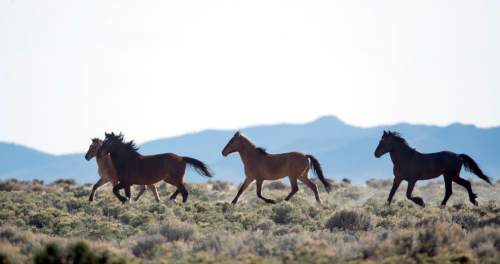This is an archived article that was published on sltrib.com in 2014, and information in the article may be outdated. It is provided only for personal research purposes and may not be reprinted.
Bureau of Land Management wranglers will return to Utah's West Desert in February to remove dozens of wild horses congregating along a remote highway.
Federal land managers say the horses are a danger to themselves and motorists.
Suspected collisions killed three horses found dead along State Road 21 last winter, according to Chad Hunter, a range and wild-horse specialists in BLM's Cedar City office.
"We were able to remove 30 head last summer. There were additional horses in the area that we tried to move away. They have moved back in," Hunter said. "We have excess numbers and they are looking for space."
The agency is fast-tracking an environmental review of the roundup, which is connected with a multiphase project to pull hundreds of horses from Utah's Sulphur Herd Management Area, a 280,000-acre block straddling Millard and Beaver counties.
Last week, the BLM initiated an Environmental Analysis of a proposal to reduce the herd's numbers to between 165 and 250 horses. This year's estimate for the herd is 718, Hunter said, and that doesn't include this year's foals.
Wild horses are a contentious issue in Utah's West Desert and Nevada, where ranchers and county commissioners complain the BLM is allowing horses to overrun the range, which leaves less forage available for cattle.
Animal-welfare advocates allege that cows, which far outnumber horses, are degrading the range. The BLM needs to allow wild horses room to roam rather than continually rounding them up for long-term storage at enormous public expense, advocates say.
In the middle of this struggle is the BLM, which is under pressure from the state to remove horses. Land managers hope contraception can become a more prominent tool in the agency's wild horse and burro program, which has relied heavily on controversial helicopter gathers.
The BLM tries to adopt out horses, but most spend the rest of their lives in corrals. Some mares are returned to the range after they are given a contraceptive.
The agency soon will be accepting public comment on its proposal to pare down the Sulphur herd, which was the subject of a roundup in 2010.
"This is a 10-year plan to get the herd to the appropriate management level as we get funding, and it includes fertility control," Hunter said.
But the removal of some 100 horses along State Road 21, a narrow strip of highway connecting Milford and Garrison, cannot wait. The February roundup will target a lonely 10-mile stretch in Millard County just west of the Desert Range Experimental Station, where the Pine and Snake valleys meet. The area is just outside the northern margin of the Sulphur HMA.



